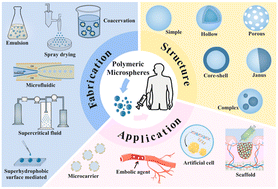Polymeric microspheres (PMs) have attracted great attention in the field of biomedicine in the last several decades due to their small particle size, special functionalities shown on the surface and high surface-to-volume ratio. However, how to fabricate PMs which can meet the clinical needs and transform laboratory achievements to industrial scale-up still remains a challenge. Therefore, advanced fabrication technologies are pursued. In this review, we summarize the technologies used to fabricate PMs, including emulsion-based methods, microfluidics, spray drying, coacervation, supercritical fluid and superhydrophobic surface-mediated method and their advantages and disadvantages. We also review the different structures, properties and functions of the PMs and their applications in the fields of drug delivery, cell encapsulation and expansion, scaffolds in tissue engineering, transcatheter arterial embolization and artificial cells. Moreover, we discuss existing challenges and future perspectives for advancing fabrication technologies and biomedical applications of PMs.
